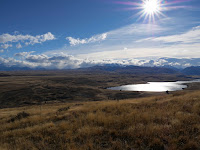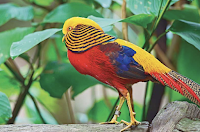Je suis passee par Dunedin, le seul endroit ou les colonies d'albatros sont visibles (les autres sont sur des iles perdues).
Ils sont au bout d’une peninsule avec une route magnifique.
Quelques fun facts (tous non alternatifs, beaucoup que je ne connaissait pas)!
Les parents couvent l’oeuf a tour de role (1 oeuf bisannuel). La regulation de la temperature se fait en contractant les vaisseaux du ventre, si c’est pas la classe… la clim est intégrée!!
Le petit a besoin de 5 jours pour eclore … un sacre boulot. Puis, pendant 8 mois les parents partent en mer et reviennent avec des calmars ou des poissons pour le petit. Le repas peut faire jusqu'a 1 kg. Ils vont engraisser leur rejeton jusqu’a 2x leur propre poids. Puis le poussin va arrêté de manger, perdre la moitie de son poids en creant ses plumes…. il pourra alors s'envoler
Le vol
Puis c’est le grand saut… Le petit prend son envol, du premier coup… et ne touchera pas le sol pendant les 5 premieres annees de sa vie.
Il part voler dans les 40eme ruggissants. Il y a la-bas beaucoup de poisson et de vent. L’albatros est un très bon planeur mais très feneant quand il s’agit de battre des ailes.
Il peut parcourir 9500km en 10 jours avec des pointes a 110km. Il fait quand meme 3 metres d’envergure.
Le premier atterrissage du jeune se fait sans les pattes.
A boire et a manger
Il dort, mange et boit en vol! Il a deux glandes dans le haut du crane pour desaliniser l’eau. Pour le poisson, il se repere aux odeurs. Quand le krill mange le plancton, du DMS (sulfure de diméthyle) est relâché dans l’air… apparement ca sent la soupe pour l’Albatros.
Il avale aussi beaucoup de plastique, le krill et le plancton s’accroche au micro plastique… donc s’il y a beaucoup de plastique, ca sent le banquet!! :S
Predateurs et harcelement… (sauf humains)
 Principalement les chats, chien pour pour poussin. Aucun pour l’adulte. Comme l’albatros n’a pas beaucoup de prédateur, le petit n’a pas développé de technique de self defense.
Principalement les chats, chien pour pour poussin. Aucun pour l’adulte. Comme l’albatros n’a pas beaucoup de prédateur, le petit n’a pas développé de technique de self defense.
La seule chose qu’il est capable de faire c’est de se vomir dessus (il a alors un certain fumet….eurk!!). Les autres oiseaux viennent le harceler car il est plus facile d’avoir son repas de l’estomac d’un albatros que d’aller le pêcher.
ll a invente la clim, la machine a déstaliniser l’eau et il peut vivre sans toucher le sol! Il est prêt pour le réchauffement climatique!
Blague a part: le Goeland d'Amsterdam ne vit plus que sur l'ile d'Amsterdam (FR) et il reste moins de 180 individus. Pour le Goeland Royal, 99% de la population niche sur des iles qui ne dépassent pas les 2 metres d'altitude.
-------------------
Ok, ok… i think you have enough of animals but i found an awesome one.

I swung by Dunedin, the only place where you have a mainland colony ( the other ones are in small remote islands).
They are on a headland with a beautiful road.
Some fun facts (non alternative, I didn’t know a lot of them)
Parents are taking turns to incubate the egg (1 biennial egg). They regulate the temperature by contracting there belly blood vessels.
The little chick needs 5 days to hatch…such a big job. For the next 8 months the parents are going on the ocean to get food (calmars and fish mainly). The load can be massive… up to 1 kg. They will feed the chick until it’s twice their size. At that point the chick will stop to eat, loose half of the weigh making feathers…and
Fly
… and jump off the cliff. No trial fly, the chick will not touch the ground for the next 5 years.
He is going to fly in the roaring 40. Because that is where you find winds and food. The albatros is a very good glider but doesn’t like to flap (sooo…. lazy!!).
It can fly up to 9500km in 10 days and up to 100km/h. It’s up to 3 meters wingspan… think about that!!
The first landing is done without legs (as he never used it before)
Food and water
It’s sleeping eating and drinking while flying. It does have 2 glands on the forehead to desalinize the water. For the food, it’s able to spot it with the smell. When the krill is eating the plancton, some DMS (dimethyl sulfide) is released in the air…. apparently it’s a call for food.
It’s also eating a lot of plastic, the krill and the plancton are sticking to plastic in the ocean… so if there is a lot of it… it’s smelling banquet.
Predators and harassment…. (Except human)
 Mainly cats, dogs… for the chick. For the adult : none. As the albatros doesn’t have predators, the chick doesn’t have any techniques to protect himself. The only thing he is doing is spill himself (so he turn to be smelly, eurk!!). Other birds are coming to arrass him, it’s easier to get the content of the chick stomack than going fishing...
Mainly cats, dogs… for the chick. For the adult : none. As the albatros doesn’t have predators, the chick doesn’t have any techniques to protect himself. The only thing he is doing is spill himself (so he turn to be smelly, eurk!!). Other birds are coming to arrass him, it’s easier to get the content of the chick stomack than going fishing...This dude has got A/C, able to produce unsalted water and can live without touching the floor! ready for global warming!!!
Joke on the side : The Amsterdam goeland lives on Amsterdam island only (FR) and count less than 180 birds. The 99% royal goélands are nesting in small islands (altitude up to 2 metres)






























